Terms Such as Naturalistic and Abstract Categorized Art by How It Related to the Appearances

Robert Delaunay, 1912–13, Le Premier Disque, 134 cm (52.7 in.), private collection
Abstract fine art uses visual linguistic communication of shape, course, color and line to create a composition which may exist with a caste of independence from visual references in the world.[1] Western art had been, from the Renaissance upwards to the heart of the 19th century, underpinned by the logic of perspective and an attempt to reproduce an illusion of visible reality. By the end of the 19th century many artists felt a demand to create a new kind of art which would encompass the fundamental changes taking identify in technology, science and philosophy. The sources from which private artists drew their theoretical arguments were various, and reflected the social and intellectual preoccupations in all areas of Western culture at that time.[2]
Abstruse art, non-figurative fine art, non-objective fine art, and non-representational art, are closely related terms. They are similar, but perchance not of identical meaning.
Brainchild indicates a deviation from reality in depiction of imagery in fine art. This departure from accurate representation can be slight, fractional, or complete. Brainchild exists along a continuum. Even art that aims for verisimilitude of the highest caste can be said to exist abstract, at to the lowest degree theoretically, since perfect representation is impossible. Artwork which takes liberties, altering for case color and grade in ways that are conspicuous, can be said to exist partially abstruse. Total abstraction bears no trace of whatsoever reference to anything recognizable. In geometric abstraction, for instance, one is unlikely to find references to naturalistic entities. Figurative fine art and full abstraction are almost mutually exclusive. Simply figurative and representational (or realistic) art often contain fractional brainchild.
Both geometric abstraction and lyrical abstraction are oft totally abstract. Amid the very numerous art movements that embody partial brainchild would exist for instance fauvism in which color is conspicuously and deliberately altered vis-a-vis reality, and cubism, which alters the forms of the real life entities depicted.[3] [four]
Abstraction in early on art and many cultures [edit]
Much of the art of before cultures – signs and marks on pottery, textiles, and inscriptions and paintings on rock – used simple, geometric and linear forms which might have had a symbolic or decorative purpose.[five] It is at this level of visual meaning that abstract art communicates.[6] One tin can enjoy the beauty of Chinese calligraphy or Islamic calligraphy without being able to read it.[7]
Islamic globe [edit]

A hilya, a decorated description of Muhammad's physical appearance, dating to the 19th century.
Islam's sometimes negative view of figurative fine art has led to the proliferation of circuitous non-figurative artistic expression across the Islamic world. Non-figurative Islamic art is nigh as sometime as Islam itself, and some of the oldest examples of it can be plant on such early buildings equally the Dome of the Stone. While Islamic art may take reservations about painting humans and animals, information technology does non, however, feel the same well-nigh plants and inanimate objects.
Islamic art traditionally revolves around calligraphy, tessellating geometric patterns, and vegetal motifs called arabesques. These elements can exist found in all Islamic applied arts, including architecture, rugmaking, pottery, glassmaking, and metalwork, likewise as decorating the borders of otherwise figurative paintings.
Equally a result of the extensive dialogue between the Christian and Islamic globe brought about by the Crusades, Islamic patterns and techniques would also come to be applied to European decorative arts, particularly in Italia and Spain. Prominent examples include Spanish Mudéjar art and Venetian Gothic architecture.
Due east Asia [edit]

Immortal in splashed ink, Liang Kai, Cathay, 12th century
In Chinese painting, abstraction can be traced to the Tang dynasty painter Wang Mo (王墨), who is credited to have invented the splashed-ink painting style.[8] While none of his paintings remain, this style is clearly seen in some Song Dynasty Paintings. The Chan buddhist painter Liang Kai (梁楷, c. 1140–1210) applied the way to effigy painting in his "Immortal in splashed ink" in which accurate representation is sacrificed to enhance spontaneity linked to the non-rational mind of the enlightened. A late Song painter named Yu Jian, expert to Tiantai buddhism, created a serial of splashed ink landscapes that eventually inspired many Japanese Zen painters. His paintings show heavily misty mountains in which the shapes of the objects are barely visible and extremely simplified. This blazon of painting was continued by Sesshu Toyo in his later years.

Mountain market place, clearing Mist, Yu Jian, People's republic of china
Another example of brainchild in Chinese painting is seen in Zhu Derun's Cosmic Circumvolve. On the left side of this painting is a pino tree in rocky soil, its branches laced with vines that extend in a disorderly manner to the right side of the painting in which a perfect circle (probably made with help of a compass[9]) floats in the void. The painting is a reflection of the Daoist metaphysics in which anarchy and reality are complementary stages of the regular course of nature.
In Tokugawa Nippon, some Zen monk-painters created Enso, a circumvolve who represents the absolute enlightenment. Usually made in 1 spontaneous castor stroke, it became the paradigm of the minimalist aesthetic that guided function of the Zen painting.
19th century [edit]
Patronage from the church building diminished and individual patronage from the public became more capable of providing a livelihood for artists.[10] [eleven] Three fine art movements which contributed to the development of abstract art were Romanticism, Impressionism and Expressionism. Artistic independence for artists was advanced during the 19th century. An objective interest in what is seen, tin exist discerned from the paintings of John Lawman, J M W Turner, Camille Corot and from them to the Impressionists who continued the plein air painting of the Barbizon school.
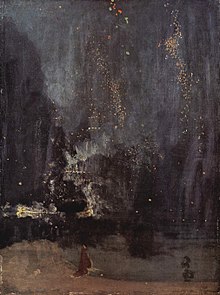
Early intimations of a new art had been made past James McNeill Whistler who, in his painting Nocturne in Black and Gold: The falling Rocket, (1872), placed greater emphasis on visual awareness than the depiction of objects. Even before than that, with her 'spirit' drawings, Georgiana Houghton's choice to work with abstract shapes correlate with the unnatural nature of her subject, in a time when abstraction" isn't yet a concept (she organized an showroom in 1871).
Expressionist painters explored the assuming employ of paint surface, drawing distortions and exaggerations, and intense color. Expressionists produced emotionally charged paintings that were reactions to and perceptions of gimmicky experience; and reactions to Impressionism and other more conservative directions of late 19th-century painting. The Expressionists drastically changed the emphasis on subject field matter in favor of the portrayal of psychological states of being. Although artists like Edvard Munch and James Ensor drew influences principally from the work of the Post-Impressionists they were instrumental to the advent of brainchild in the 20th century. Paul Cézanne had begun as an Impressionist but his aim – to make a logical construction of reality based on a view from a single point,[xiv] with modulated colour in apartment areas – became the basis of a new visual art, later on to be developed into Cubism past Georges Braque and Pablo Picasso.
Additionally in the late 19th century in Eastern Europe mysticism and early modernist religious philosophy every bit expressed by theosophist Mme. Blavatsky had a profound bear upon on pioneer geometric artists similar Hilma af Klint and Wassily Kandinsky. The mystical educational activity of Georges Gurdjieff and P.D. Ouspensky also had an important influence on the early formations of the geometric abstract styles of Piet Mondrian and his colleagues in the early 20th century.[fifteen] The spiritualism besides inspired the abstruse art of Kasimir Malevich and František Kupka.[xvi]
20th century [edit]

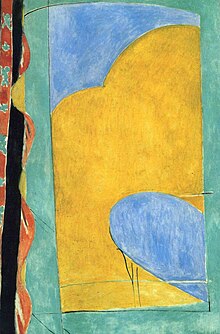
Post-Impressionism as practiced by Paul Gauguin, Georges Seurat, Vincent van Gogh and Paul Cézanne had an enormous impact on 20th-century fine art and led to the advent of 20th-century abstraction. The heritage of painters similar Van Gogh, Cézanne, Gauguin, and Seurat was essential for the development of modern art. At the get-go of the 20th century Henri Matisse and several other immature artists including the pre-cubist Georges Braque, André Derain, Raoul Dufy and Maurice de Vlaminck revolutionized the Paris art world with "wild", multi-colored, expressive landscapes and figure paintings that the critics called Fauvism. With his expressive employ of color and his gratuitous and imaginative cartoon Henri Matisse comes very close to pure abstraction in French Window at Collioure (1914), View of Notre-Dame (1914), and The Yellowish Drape from 1915. The raw language of colour as developed by the Fauves directly influenced another pioneer of brainchild, Wassily Kandinsky.
Although Cubism ultimately depends upon subject area matter, information technology became, along with Fauvism, the fine art movement that directly opened the door to brainchild in the 20th century. Pablo Picasso made his starting time cubist paintings based on Cézanne's idea that all depiction of nature can exist reduced to three solids: cube, sphere and cone. With the painting Les Demoiselles d'Avignon (1907), Picasso dramatically created a new and radical picture depicting a raw and archaic brothel scene with 5 prostitutes, violently painted women, reminiscent of African tribal masks and his own new Cubist inventions. Analytic cubism was jointly developed by Pablo Picasso and Georges Braque, from virtually 1908 through 1912. Analytic cubism, the first clear manifestation of cubism, was followed past Constructed cubism, practiced by Braque, Picasso, Fernand Léger, Juan Gris, Albert Gleizes, Marcel Duchamp and others into the 1920s. Constructed cubism is characterized by the introduction of different textures, surfaces, collage elements, papier collé and a big diversity of merged subject area affair. The collage artists like Kurt Schwitters and Human Ray and others taking the inkling from Cubism were instrumental to the development of the movement chosen Dada.
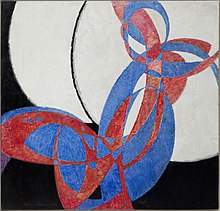
František Kupka, Amorpha, Fugue en deux couleurs (Fugue in Ii Colors), 1912, oil on sail, 210 10 200 cm, Narodni Galerie, Prague. Published in Au Salon d'Automne "Les Indépendants" 1912, Exhibited at the 1912 Salon d'Automne, Paris.

Robert Delaunay, 1912, Windows Open Simultaneously (First Role, Third Motif), oil on canvas, 45.7 × 37.v cm, Tate Mod
The Italian poet Filippo Tommaso Marinetti published the Manifesto of Futurism in 1909, which later inspired artists such as Carlo Carra in Painting of Sounds, Noises and Smells and Umberto Boccioni Train in Move, 1911, to a further stage of abstraction that would, forth with Cubism, profoundly influenced fine art movements throughout Europe.[17]
During the 1912 Salon de la Section d'Or, where František Kupka exhibited the abstract painting Amorpha, Fugue en deux couleurs (Fugue in Two Colors) (1912), the poet Guillaume Apollinaire named the work of several artists including Robert Delaunay, Orphism.[eighteen] He defined information technology as, "the art of painting new structures out of elements that have not been borrowed from the visual sphere, only had been created entirely by the artist...information technology is a pure art."[19]
Since the turn of the century, cultural connections between artists of the major European cities had get extremely active as they strove to create an art course equal to the loftier aspirations of modernism. Ideas were able to cross-fertilize by ways of creative person's books, exhibitions and manifestos and then that many sources were open to experimentation and discussion, and formed a basis for a diversity of modes of abstraction. The following extract from The Globe Backwards gives some impression of the inter-connectedness of civilization at the fourth dimension: "David Burliuk's noesis of mod art movements must have been extremely up-to-date, for the second Knave of Diamonds exhibition, held in January 1912 (in Moscow) included not only paintings sent from Munich, but some members of the German Dice Brücke group, while from Paris came work past Robert Delaunay, Henri Matisse and Fernand Léger, besides as Picasso. During the Spring David Burliuk gave 2 lectures on cubism and planned a polemical publication, which the Knave of Diamonds was to finance. He went abroad in May and came back determined to rival the almanac Der Blaue Reiter which had emerged from the printers while he was in Germany".[twenty]
From 1909 to 1913 many experimental works in the search for this 'pure art' had been created by a number of artists: Francis Picabia painted Caoutchouc, c. 1909,[21] The Bound, 1912,[22] Dances at the Spring [23] and The Procession, Seville, 1912;[24] Wassily Kandinsky painted Untitled (Starting time Abstract Watercolor), 1913,[25] Improvisation 21A, the Impression series, and Pic with a Circle (1911);[26] František Kupka had painted the Orphist works, Discs of Newton (Study for Fugue in Two Colors), 1912[27] and Amorpha, Fugue en deux couleurs (Fugue in Two Colors), 1912; Robert Delaunay painted a series entitled Simultaneous Windows and Formes Circulaires, Soleil due north°two (1912–13);[28] Léopold Survage created Colored Rhythm (Study for the picture), 1913;[29] Piet Mondrian, painted Tableau No. 1 and Composition No. eleven, 1913.[30]

Wassily Kandinsky, untitled (study for Limerick VII, Première abstraction), watercolor, 1913[31]

And the search connected: The Rayist (Luchizm) drawings of Natalia Goncharova and Mikhail Larionov, used lines like rays of calorie-free to make a construction. Kasimir Malevich completed his first entirely abstruse work, the Suprematist, Black Square, in 1915. Another of the Suprematist group' Liubov Popova, created the Architectonic Constructions and Spatial Force Constructions between 1916 and 1921. Piet Mondrian was evolving his abstract linguistic communication, of horizontal and vertical lines with rectangles of color, between 1915 and 1919, Neo-Plasticism was the aesthetic which Mondrian, Theo van Doesburg and other in the grouping De Stijl intended to reshape the environs of the future.
Music [edit]
Every bit visual art becomes more abstract, it develops some characteristics of music[ citation needed ]: an art form which uses the abstract elements of sound and divisions of time. Wassily Kandinsky, himself an amateur musician,[32] [33] [34] was inspired by the possibility of marks and associative colour resounding in the soul. The idea had been put forward by Charles Baudelaire, that all our senses respond to diverse stimuli but the senses are connected at a deeper artful level.
Closely related to this, is the idea that fine art has The spiritual dimension and tin can transcend 'every-day' feel, reaching a spiritual plane. The Theosophical Gild popularized the ancient wisdom of the sacred books of Bharat and China in the early years of the century. It was in this context that Piet Mondrian, Wassily Kandinsky, Hilma af Klint and other artists working towards an 'objectless state' became interested in the occult equally a way of creating an 'inner' object. The universal and timeless shapes found in geometry: the circle, square and triangle go the spatial elements in abstract art; they are, like colour, fundamental systems underlying visible reality.
Russian avant-garde [edit]
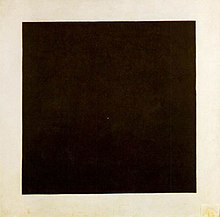
Many of the abstract artists in Russia became Constructivists assertive that art was no longer something remote, but life itself. The creative person must become a technician, learning to employ the tools and materials of modern production. Art into life! was Vladimir Tatlin's slogan, and that of all the time to come Constructivists. Varvara Stepanova and Alexandre Exter and others abandoned easel painting and diverted their energies to theatre design and graphic works. On the other side stood Kazimir Malevich, Anton Pevsner and Naum Gabo. They argued that fine art was essentially a spiritual activity; to create the individual's identify in the earth, not to organize life in a practical, materialistic sense. Many of those who were hostile to the materialist production thought of art left Russia. Anton Pevsner went to France, Gabo went first to Berlin, then to England and finally to America. Kandinsky studied in Moscow then left for the Bauhaus. Past the mid-1920s the revolutionary menses (1917 to 1921) when artists had been free to experiment was over; and by the 1930s merely socialist realism was allowed.[35]
The Bauhaus [edit]
The Bauhaus at Weimar, Germany was founded in 1919 by Walter Gropius.[36] The philosophy underlying the teaching plan was unity of all the visual and plastic arts from compages and painting to weaving and stained glass. This philosophy had grown from the ideas of the Arts and crafts movement in England and the Deutscher Werkbund. Among the teachers were Paul Klee, Wassily Kandinsky, Johannes Itten, Josef Albers, Anni Albers, and László Moholy-Nagy. In 1925 the school was moved to Dessau and, as the Nazi political party gained command in 1932, The Bauhaus was airtight. In 1937 an exhibition of degenerate art, 'Entartete Kunst' contained all types of avant-garde art disapproved of past the Nazi political party. And then the exodus began: not simply from the Bauhaus but from Europe in general; to Paris, London and America. Paul Klee went to Switzerland merely many of the artists at the Bauhaus went to America.
Abstraction in Paris and London [edit]
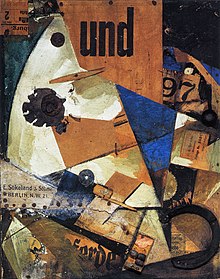
During the 1930s Paris became the host to artists from Russian federation, Germany, the Netherlands and other European countries affected by the rise of totalitarianism. Sophie Tauber and Jean Arp collaborated on paintings and sculpture using organic/geometric forms. The Polish Katarzyna Kobro applied mathematically based ideas to sculpture. The many types of abstraction at present in shut proximity led to attempts past artists to analyse the various conceptual and artful groupings. An exhibition past forty-six members of the Cercle et Carré grouping organized by Joaquín Torres-García[37] assisted by Michel Seuphor[38] independent work by the Neo-Plasticists likewise as abstractionists every bit varied every bit Kandinsky, Anton Pevsner and Kurt Schwitters. Criticized by Theo van Doesburg to exist likewise indefinite a collection he published the journal Art Concret setting out a manifesto defining an abstruse art in which the line, color and surface only, are the physical reality.[39] Abstraction-Création founded in 1931 every bit a more open group, provided a point of reference for abstract artists, as the political situation worsened in 1935, and artists again regrouped, many in London. The first exhibition of British abstruse art was held in England in 1935. The following year the more international Abstract and Physical exhibition was organized by Nicolete Gray including work by Piet Mondrian, Joan Miró, Barbara Hepworth and Ben Nicholson. Hepworth, Nicholson and Gabo moved to the St. Ives group in Cornwall to continue their 'constructivist' work.[40]
America: mid-century [edit]

A 1939–1942 oil on canvass painting past Piet Mondrian titled Composition No. 10. Responding to it, beau De Stijl artist Theo van Doesburg suggested a link between non-representational works of art and ethics of peace and spirituality.[41]
During the Nazi rising to ability in the 1930s many artists fled Europe to the Usa. Past the early 1940s the main movements in modernistic art, expressionism, cubism, abstraction, surrealism, and dada were represented in New York: Marcel Duchamp, Fernand Léger, Piet Mondrian, Jacques Lipchitz, André Masson, Max Ernst, André Breton, were just a few of the exiled Europeans who arrived in New York.[42] The rich cultural influences brought by the European artists were distilled and built upon by local New York painters. The climate of freedom in New York immune all of these influences to flourish. The art galleries that primarily had focused on European art began to notice the local art community and the work of younger American artists who had begun to mature. Certain artists at this time became distinctly abstract in their mature piece of work. During this period Piet Mondrian'due south painting Limerick No. 10, 1939–1942, characterized by master colors, white ground and black grid lines clearly defined his radical but classical approach to the rectangle and abstract art in general. Some artists of the menses defied categorization, such as Georgia O'Keeffe who, while a modernist abstractionist, was a pure maverick in that she painted highly abstract forms while not joining any specific grouping of the period.
Eventually American artists who were working in a great variety of styles began to coagulate into cohesive stylistic groups. The best-known group of American artists became known as the Abstract expressionists and the New York School. In New York Metropolis at that place was an atmosphere which encouraged discussion and there was a new opportunity for learning and growing. Artists and teachers John D. Graham and Hans Hofmann became important bridge figures betwixt the newly arrived European Modernists and the younger American artists coming of historic period. Mark Rothko, born in Russian federation, began with strongly surrealist imagery which later on dissolved into his powerful color compositions of the early 1950s. The expressionistic gesture and the act of painting itself, became of chief importance to Jackson Pollock, Robert Motherwell, and Franz Kline. While during the 1940s Arshile Gorky'due south and Willem de Kooning's figurative work evolved into brainchild by the end of the decade. New York City became the center, and artists worldwide gravitated towards it; from other places in America also.[43]
Later developments [edit]
Digital fine art, hard-border painting, geometric brainchild, minimalism, lyrical abstraction, op art, abstract expressionism, color field painting, monochrome painting, assemblage, neo-Dada, shaped canvas painting, are a few directions relating to brainchild in the second half of the 20th century.
In the Usa, Art equally Object as seen in the Minimalist sculpture of Donald Judd and the paintings of Frank Stella are seen today equally newer permutations. Other examples include Lyrical Abstraction and the sensuous use of color seen in the work of painters equally diverse as Robert Motherwell, Patrick Heron, Kenneth Noland, Sam Francis, Cy Twombly, Richard Diebenkorn, Helen Frankenthaler, Joan Mitchell.
Causation [edit]
1 socio-historical caption that has been offered for the growing prevalence of the abstract in modern art – an explanation linked to the name of Theodor W. Adorno – is that such abstraction is a response to, and a reflection of, the growing abstraction of social relations in industrial club.[44]
Frederic Jameson similarly sees modernist abstraction as a function of the abstruse power of money, equating all things every bit as commutation-values.[45] The social content of abstract art is then precisely the abstract nature of social existence – legal formalities, bureaucratic impersonalization, information/ability – in the earth of belatedly modernity.[46]
Post-Jungians by dissimilarity would see the quantum theories with their disintegration of conventional ideas of class and thing as underlying the divorce of the concrete and the abstruse in modernistic art.[47]
Gallery [edit]
-
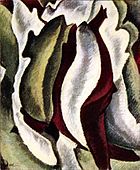
Arthur Dove, 1911–12, Based on Leafage Forms and Spaces, pastel on unidentified back up. Now lost
-
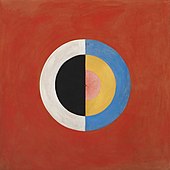
Hilma af Klint, Svanen (The Swan), No. 17, Group Ix, Series SUW, October 1914–March 1915. This abstract work was never exhibited during af Klint's lifetime.
-

Albert Gleizes, 1921, Limerick bleu et jaune (Composition jaune), oil on canvas, 200.v × 110 cm
-
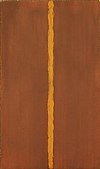
See likewise [edit]
- Abstruse fine art and Theosophy
- Abstract expressionism
- Abstraction in art
- Action painting
- American Abstract Artists
- Art history
- Art periods
- Asemic writing
- Colour field
- Physical art
- De Stijl
- Geometric brainchild
- Hard-edge
- History of painting
- Lyrical abstraction
- Op Art
- Representation (arts)
- Spatialism
- Surrealism
- Western painting
- In other media
- Abstract animation
- Abstract comics
- Abstract photography
- Experimental film
- Literary nonsense
- Musique concréte
- Noise music
References [edit]
- ^ Rudolph Arnheim, Visual Thinking, University of California Press, 1969, ISBN 0-520-01871-0
- ^ Mel Gooding, Abstruse Fine art, Tate Publishing, London, 2000
- ^ "Abstract Art – What Is Abstract Art or Abstract Painting, retrieved January 7, 2009". Painting.about.com. 2011-06-07. Archived from the original on seven July 2011. Retrieved 2011-06-11 .
- ^ "Themes in American Fine art – Abstraction, retrieved January vii, 2009". Nga.gov. 2000-07-27. Archived from the original on viii June 2011. Retrieved 2011-06-11 .
- ^ György Kepes, Sign, Image and Symbol, Studio Vista, London, 1966
- ^ Derek Hyatt,"Meeting on the Moor", Modern Painters, Fall 1995
- ^ Simon Leys, 2013. The Hall of Uselessness: Collected Essays. New York: New York Review Books. p. 304. ISBN 978-1-59017-620-7.
- ^ Lippit, Y. (2012). "Of Modes and Manners in Japanese Ink Painting: Sesshū's Splashed Ink Mural of 1495". The Art Bulletin, 94(1), p. 56.
- ^ Watt, J. C. (2010). The World of Khubilai Khan: Chinese Art in the Yuan Dynasty. Metropolitan Museum of Art, p. 224
- ^ Ernst Gombrich, "The Early on Medici as Patrons of Art" in Norm and Form, pp. 35–57, London, 1966
- ^ Judith Balfe, ed. Paying the Piper: Causes and Consequences of Art Patronage, Univ. of Illinois Printing
- ^ Whistler versus Ruskin, Princeton edu. Archived June sixteen, 2010, at the Wayback Machine Retrieved June 13, 2010
- ^ From the Tate Archived 2012-01-12 at the Wayback Machine, retrieved April 12, 2009
- ^ Herbert Read, A Concise History of Modern Fine art, Thames and Hudson
- ^ "Hilton Kramer, "Mondrian & mysticism: My long search is over", New Criterion, September 1995". Newcriterion.com. Retrieved 2012-02-26 .
- ^ Brenson, Michael (Dec 21, 1986). "Fine art View; How the Spiritual Infused the Abstruse". The New York Times.
- ^ Caroline Tisdall and Angelo Bozzolla, Futurism, Thames and Hudson, 1977
- ^ La Section d'or, 1912–1920–1925, Cécile Debray, Françoise Lucbert, Musées de Châteauroux, Musée Fabre, exhibition catalogue, Éditions Cercle d'art, Paris, 2000
- ^ Harrison and Wood, Art in theory, 1900–2000, Wiley-Blackwell, 2003, p. 189. ISBN 978-0-631-22708-three.books.google.com"
- ^ Susan P Compton, The World Backwards, British museum Publications, London, 1978
- ^ "Francis Picabia, Caoutchouc, c. 1909, MNAM, Paris". Francispicabia.org. Retrieved 2013-09-29 .
- ^ "Museum of Mod Art, New York, Francis Picabia, The Spring, 1912". Moma.org. Retrieved 2013-09-29 .
- ^ "MoMA, New York, Francis Picabia, Dances at the Spring, 1912". Moma.org. Retrieved 2013-09-29 .
- ^ "National Gallery of Fine art, Washington, DC., Francis Picabia, The Procession, Seville, 1912". Nga.gov. Archived from the original on 2012-08-05. Retrieved 2013-09-29 .
- ^ Stan Rummel (2007-12-13). "Wassily Kandinsky, Untitled (First Abstract Watercolor), 1910". Kinesthesia.txwes.edu. Archived from the original on 2012-07-nineteen. Retrieved 2013-09-29 .
- ^ "The Fiftieth Ceremony of the Guggenheim Museum, Kandinsky Retrospective, Guggenheim Museum, New York, 2009" (PDF). Archived from the original (PDF) on 2012-07-eighteen. Retrieved 2013-09-29 .
- ^ "Philadelphia Museum of Fine art, Disks of Newton (Study for "Fugue in Two Colors") 1912". Philamuseum.org. Retrieved 2013-09-29 .
- ^ "Musée National d'Fine art Moderne, Centre Georges Pompidou, Paris, Robert Delaunay, Formes Circulaires, Soleil northward°2 (1912–13)" (in French). Centrepompidou.fr. Archived from the original on September 7, 2012. Retrieved 2013-09-29 .
- ^ "Museum of Mod Art, New York, Léopold Survage, Colored Rhythm (Study for the film) 1913". Moma.org. 1914-07-15. Retrieved 2013-09-29 .
- ^ "Rijksmuseum Kröller-Müller, Otterlo, Netherlands, Piet Mondrian, 1913". Kmm.nl. Archived from the original on October 2, 2013. Retrieved 2013-09-29 .
- ^ Wassily Kandinsky, Untitled (study for Composition 7, Première abstraction), watercolor, 1913 Archived 2018-07-22 at the Wayback Machine, MNAM, Center Pompidou
- ^ Shawn, Allen. 2003. Arnold Schoenberg's Journey. Harvard University Printing. p. 62. ISBN 0-674-01101-five
- ^ François Le Targat, Kandinsky, Twentieth Century masters series, Random House Incorporated, 1987, p. 7, ISBN 0-8478-0810-6
- ^ Susan B. Hirschfeld, Solomon R. Guggenheim Museum, Hilla von Rebay Foundation, Watercolors by Kandinsky at the Guggenheim Museum: a selection from the Solomon R. Guggenheim Museum and the Hilla von Rebay Foundation, 1991. In 1871 the family unit moved to Odessa, where the young Kandinsky attended the Gymnasium and learned to play the cello and pianoforte.
- ^ Camilla Greyness, The Russian Experiment in Fine art, 1863–1922, Thames and Hudson, 1962
- ^ Walter Gropius et al., Bauhaus 1919–1928 Herbert Bayer ed., Museum of Modern Art, publ. Charles T Banford, Boston,1959
- ^ Seuphor, Michel (1972). Geometric Abstraccion 1926-1949. Dallas Museum of Fine Arts.
- ^ Michel Seuphor, Abstract Painting
- ^ Anna Moszynska, Abstract Art, p. 104, Thames and Hudson, 1990
- ^ Anna Moszynska, Abstract Fine art, Thames and Hudson, 1990
- ^ Utopian Reality: Reconstructing Culture in Revolutionary Russian federation and Beyond; Christina Lodder, Maria Kokkori, Maria Mileeva; BRILL, October 24, 2013 "Van Doesburg stated that the purpose of art was to imbue man with those positive spiritual qualities that were needed in order to overcome the dominance of the physical and create the weather condition for putting an finish to wars. In an enthusiastic essay on Wassily Kandinsky he had written well-nigh the dialogue between the creative person and the viewer, and the role of art as 'the educator of our inner life, the educator of our hearts and minds'. Van Doesburg after adopted the view that the spiritual in man is nurtured specifically past abstract art, which he later described as 'pure idea, which does not signify a concept derived from natural phenomena simply which is independent in numbers, measures, relationships, and abstract lines'. In his response to Piet Mondrian's Limerick 10, Van Doesburg linked peace and the spiritual to a non-representational work of fine art, asserting that 'information technology produces a most spiritual impression...the impression of repose: the placidity of the soul'."
- ^ Gillian Naylor, The Bauhaus, Studio Vista, 1968
- ^ Henry Geldzahler, New York Painting and Sculpture: 1940–1970, Metropolitan Museum of Modern Art, 1969
- ^ David Cunningham, 'Asceticism Confronting Color', in New Formations 55 (2005) p. 110
- ^ M. Hardt/K. Weeks eds., The Jameson Reader (2000) p. 272
- ^ Cunningham, p. 114
- ^ Aniela Jaffé, in C. Thou. Jung ed., Man and his Symbols (1978) pp. 288–89, 303
Sources [edit]
- ^ Compton, Susan (1978). The Globe Backwards: Russian Futurist Books 1912–sixteen. The British Library. ISBN978-0-7141-0396-ix.
- ^ Stangos, Nikos, ed. (1981). Concepts of Modern Fine art. Thames and Hudson. ISBN978-0-500-20186-two.
- ^ Gooding, Mel (2001). Abstract Fine art. Movements in Modern Art series. Tate Publishing. ISBN978-1-85437-302-1.
- ^ Rump, Gerhard Charles (1985). How to look at an abstruse painting. Inter Nationes.
External links [edit]
- The term "Abstraction" spoken nigh at Museum of Modern Art past Nelson Goodman of Grove Fine art Online
- Tate U.k. "Abstruse art is..."
Source: https://en.wikipedia.org/wiki/Abstract_art
0 Response to "Terms Such as Naturalistic and Abstract Categorized Art by How It Related to the Appearances"
Postar um comentário